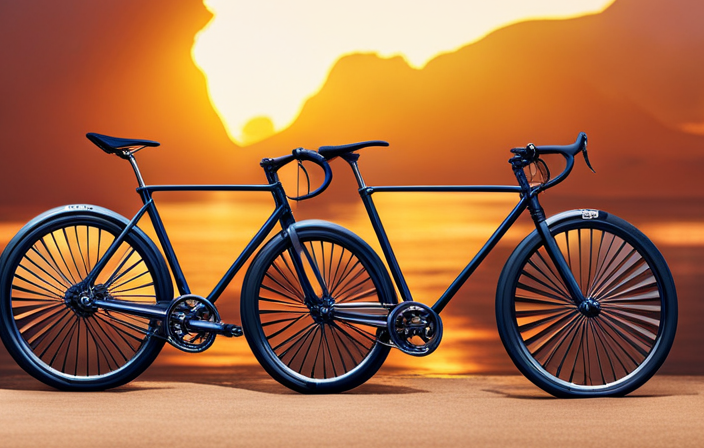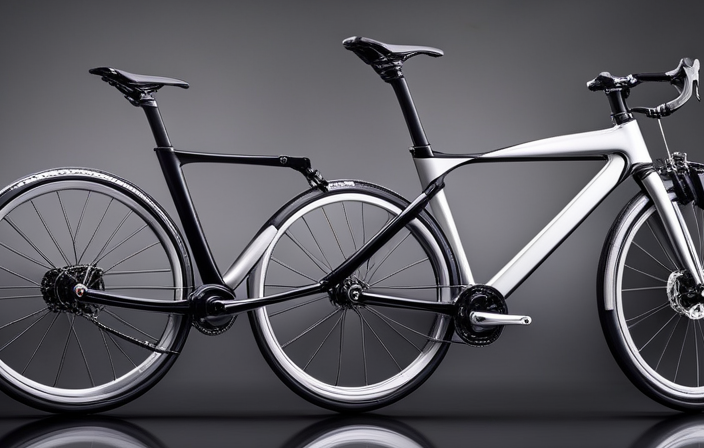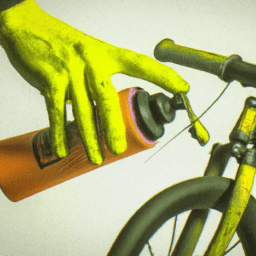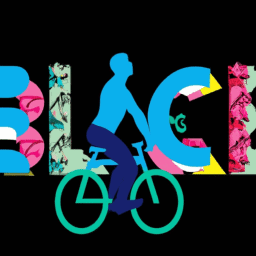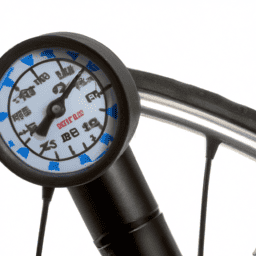Looking for a new bike? You’re in luck because this is the perfect spot for you! Get ready for some great tips and secrets on finding the ideal ride for you. Let’s pedal forward together!
In this article, we’ll dive into the world of bicycles and explore how much they really cost. From the various types of bicycles and their price ranges to the factors that affect the cost, we’ll cover it all.
So sit back, relax, and let’s find out just how much you’ll need to shell out to get your hands on that perfect ride.
Key Takeaways
- The price range for new bicycles can vary depending on the type, with basic bikes costing $200-$500, mid-range bikes costing $500-$1,500, and high-end bikes costing $1,500-$10,000+.
- The cost of a new bicycle can be influenced by factors such as bike color options, custom bike options, brand and reputation, bike frame material, and components and accessories.
- Established brands with a strong reputation often charge higher prices for their bicycles.
- The choice of bike frame material, such as aluminum, carbon fiber, or steel, can impact the weight, durability, and cost of the bicycle.
Types of Bicycles and Their Price Ranges
So, how much are you willing to spend on a new bike?
When it comes to bicycles, there are various types and price ranges to consider. If you’re looking for a basic, no-frills option, you can expect to spend around $200 to $500. These bikes are perfect for casual riders and typically come with standard features like gears, brakes, and comfortable seats.
If you’re willing to splurge a bit more, you can explore the mid-range options that range from $500 to $1,500. These bikes often offer better components, lighter frames, and improved performance.
For the avid cyclists or those looking for specialized features, high-end bikes can cost anywhere from $1,500 to $10,000 or more. These bikes are built with top-of-the-line materials and advanced technology, making them suitable for professional riders or enthusiasts.
It’s worth noting that the price of a bike can also be influenced by additional factors such as bike accessories and bike locks.
Now, let’s dive into the factors that affect the cost of a new bicycle.
Factors that Affect the Cost of a New Bicycle
To determine the price of a bicycle, you should consider various factors.
One factor is the bike color options available. Some manufacturers offer a range of colors to choose from, while others may have limited options. The color of your bike can affect its price, as certain colors may be more popular or require additional customization.
Speaking of customization, another factor that can affect the cost of a new bicycle is the availability of custom bike options. Some brands offer the ability to customize your bike with different components, such as a specific type of handlebar or saddle. These custom options can add to the overall cost of the bike.
Moving on to the next section about brand and reputation, it is important to consider these factors when determining the price of a new bicycle.
Brand and Reputation
When considering which brand to choose for your bike, it’s important to take into account its reputation and how it may impact the overall cost.
Brand reputation plays a significant role in the pricing of bicycles. Established brands with a strong reputation often come with a higher price tag, as customers are willing to pay for the assurance of quality and reliability. Brands that have been in the market for a long time and have a loyal customer base tend to charge more for their products.
Additionally, customer reviews can give you valuable insight into the reputation of a brand. By reading reviews from other cyclists, you can gauge the level of satisfaction with a particular brand and make an informed decision.
Moving on to the subsequent section about ‘bike frame material,’ it’s crucial to understand how this factor affects the cost of a new bicycle.
Bike Frame Material
The choice of bike frame material significantly impacts the overall cost of a bike. There are several different bike frame materials available, each with its own advantages and disadvantages.
One common material is aluminum, which is lightweight and affordable. It provides a smooth ride and is resistant to rust. However, aluminum frames can be less durable than other materials and may not absorb shock as well.
Another popular option is carbon fiber, which is extremely lightweight and offers excellent shock absorption. Carbon fiber frames are also known for their stiffness and responsiveness. However, they tend to be more expensive than aluminum frames.
Steel frames, on the other hand, are known for their durability and strength. They provide a comfortable ride but can be heavier compared to aluminum or carbon fiber.
In the next section, we will discuss the importance of components and accessories when considering the cost of a new bike.
Components and Accessories
Components and accessories play a crucial role in determining the overall cost and performance of a bike. When considering a new bicycle, it’s important to understand the different components and accessories available.
Here are four key items to consider:
-
Drivetrain: This includes the gears, chain, and crankset. A higher-end drivetrain can improve shifting precision and overall performance.
-
Brakes: There are various types of brakes, such as rim brakes and disc brakes. Disc brakes tend to offer better stopping power and control, especially in wet conditions.
-
Wheels: The type of wheels can greatly affect the bike’s weight, aerodynamics, and durability. Lighter wheels can improve acceleration, while sturdier wheels are ideal for off-road riding.
-
Accessories: From bike lights to water bottle cages, accessories enhance the functionality and convenience of your ride. Consider what accessories are necessary for your specific needs.
Understanding these bike components and accessories will help you make an informed decision about which ones are worth investing in.
Now, let’s delve into the importance of bike size and fit.
Bike Size and Fit
When it comes to buying a new bicycle, it’s not just about the components and accessories; you also need to consider the bike size and fit. This is an often overlooked aspect, but it plays a crucial role in your comfort and performance while riding. Proper bike fit is essential to avoid discomfort, pain, and even injuries. To ensure a good fit, you should follow some basic bike size guidelines. These guidelines take into account your height, leg inseam, and reach. By finding the right bike size, you can optimize your riding position and maximize your power output. Additionally, a well-fitting bike allows for better control and handling, enhancing your overall riding experience. Now that we understand the importance of bike fit and size, let’s explore the next section on specialized features and technology.
Specialized Features and Technology
To enhance your riding experience, you should consider the specialized features and technology available in bikes. Today’s bicycles are equipped with advanced technology and specialized features that can greatly improve your performance and comfort on the road.
Here are some key features to look out for:
-
Suspension systems: These can absorb shocks and bumps, providing a smoother ride on rough terrains.
-
Electronic shifting: This technology allows for quick and precise gear changes with just the push of a button.
-
Disc brakes: Offering powerful and consistent stopping power, disc brakes are superior to traditional rim brakes.
-
Carbon fiber frames: Lightweight and strong, carbon fiber frames provide a stiff and responsive ride.
-
Tubeless tires: These eliminate the need for inner tubes, reducing the risk of flats and improving traction.
Considering the specialized features and advanced technology available in bikes will ensure that you find a bicycle that meets your specific needs.
Now, let’s explore the average price range for different types of bicycles.
Average Price Range for Different Types of Bicycles
The average price range for various types of bikes can vary greatly depending on factors such as brand, materials, and features. When it comes to bike maintenance and choosing the right gear, it is important to consider your budget. To give you an idea of the average price range for different types of bicycles, I have compiled a table below:
| Type of Bicycle | Average Price Range |
|---|---|
| Mountain Bike | $500 – $3,000 |
| Road Bike | $800 – $10,000 |
| Hybrid Bike | $300 – $1,000 |
| Electric Bike | $1,000 – $5,000 |
| Folding Bike | $200 – $1,500 |
As you can see, the price range can vary significantly depending on the type of bike you are interested in. Now, let’s move on to the next section where we will discuss road bikes in more detail.
Road Bikes
If you’re looking for a versatile and efficient ride, road bikes are a great option. These bikes are designed specifically for riding on paved surfaces, making them ideal for commuting, racing, or long-distance rides.
Road bikes are known for their lightweight frames, aerodynamic design, and narrow, high-pressure tires that reduce rolling resistance. To keep your road bike in top condition, regular maintenance is crucial. This includes cleaning and lubricating the drivetrain, checking tire pressure, and inspecting the brakes.
Additionally, there are various accessories that can enhance your road biking experience. These may include a helmet, cycling shoes, gloves, and a cycling computer to track your speed and distance.
Moving on to mountain bikes, they offer a different set of features and capabilities.
Mountain Bikes
Get ready to tackle the trails with a mountain bike that offers rugged durability and superior off-road performance. Mountain bikes are designed specifically for off-road adventures, with features like wide, knobby tires, suspension systems, and sturdy frames that can withstand the demands of rough terrain.
Whether you’re a beginner or an experienced rider, mountain bike trails offer a thrilling and challenging experience. However, it’s important to remember that regular maintenance is crucial to keep your mountain bike in top condition. This includes checking tire pressure, cleaning and lubricating the chain, and inspecting the brakes and gears. By keeping up with bike maintenance, you can ensure that your mountain bike will continue to perform at its best on the trails.
Now, let’s move on to the next section and explore hybrid bikes.
Hybrid Bikes
Hybrid bikes combine the best features of road bikes and mountain bikes. They are designed to offer a comfortable and efficient riding experience on a variety of terrains.
Versatility: Hybrid bikes are suitable for both on-road and off-road cycling, making them a great choice for riders who want to explore different types of terrain.
Comfort: With their upright riding position and padded seats, hybrid bikes provide a more comfortable ride compared to road bikes, especially on longer journeys.
All-weather performance: Hybrid bikes are equipped with wider tires that provide better traction and stability, making them ideal for riding in different weather conditions.
However, there are a few disadvantages to consider. Hybrid bikes tend to be heavier and slower than road bikes, and they may not offer the same level of performance and agility as mountain bikes on rough trails.
Moving on to electric bikes, these innovative bicycles offer an added boost of power with their electric motors.
Electric Bikes
Electric bikes, also known as e-bikes, provide riders with an extra boost of power to make cycling easier and more enjoyable. These bikes have become increasingly popular due to their many features and benefits. Electric bikes come with a battery-powered motor that assists the rider while pedaling, allowing them to travel longer distances and tackle challenging terrains with ease. They usually have multiple power levels, allowing riders to choose the amount of assistance they need. Some electric bikes even come with a throttle, which allows riders to control the speed without pedaling. Additionally, electric bikes often have features like built-in lights, fenders, and racks, making them suitable for commuting and carrying cargo. With their ability to enhance the cycling experience, electric bikes have revolutionized the way people travel and explore, providing a greener and more efficient alternative to traditional bikes. Speaking of innovation, the next section will focus on folding bikes.
Folding Bikes
If you’re looking for a convenient and compact way to commute, folding bikes are a great option. These innovative bicycles have gained popularity due to their unique advantages.
One of the main advantages of folding bikes is their portability. They can be easily folded and stored in small spaces like your car trunk or under your desk at work. This makes them ideal for those with limited storage space.
Additionally, folding bikes are versatile and can be used for various terrains. They are lightweight and easy to maneuver, making them suitable for urban environments.
However, there are also some disadvantages to consider. Folding bikes tend to have smaller wheels, which can affect their stability and speed compared to traditional bicycles. They may also have a higher price tag due to their specialized design.
Despite these drawbacks, folding bikes offer a convenient and efficient way to travel.
Now, let’s explore where to buy a new bicycle.
Where to Buy a New Bicycle
Looking for a place to purchase a bike? When buying a new bicycle, you have two main options: buying online or visiting local bike shops. Both options have their advantages and it ultimately depends on your personal preferences.
If you choose to buy online, you can enjoy the convenience of browsing through a wide selection of bikes from the comfort of your home. Online retailers often offer competitive prices and provide detailed product descriptions and customer reviews to help you make an informed decision. However, you won’t be able to test ride the bike before purchasing it.
On the other hand, local bike shops provide the opportunity to physically see and test ride the bike before making a purchase. The staff at these shops are knowledgeable and can provide expert advice based on your specific needs and preferences. Additionally, they often offer maintenance services and warranties.
Transitioning to the next section, local bike shops offer a more personalized experience and can provide the necessary assistance in finding the perfect bike for you.
Local Bike Shops
When shopping for a bike, you’ll find that local bike shops offer a personalized experience and can help you find the perfect fit. Here are four reasons why local bike shops are a great option:
-
Expertise: Local bike shops have knowledgeable staff who can guide you through the buying process, ensuring you get a bike that suits your needs and preferences.
-
Test rides: Unlike online retailers, local bike shops allow you to test ride different models, helping you make an informed decision.
-
Bike repairs and services: Local bike shops not only sell bikes but also offer repair and maintenance services. They have the expertise to keep your bike in top condition throughout its lifespan.
-
Community support: By choosing to shop at local bike shops, you are supporting local businesses and fostering a sense of community.
With the benefits of local bike shops in mind, let’s now explore the convenience of online retailers for bike shopping.
Online Retailers
When shopping for a bike, you might consider online retailers for the convenience they offer in terms of selection and delivery options. Online retailers provide a wide range of bicycles to choose from, allowing you to compare different brands, models, and prices all in one place. Additionally, online reviews from other customers can give you valuable insights into the quality and performance of a particular bike. Customer satisfaction is also an important factor to consider, as online retailers often provide a platform for customers to leave feedback and ratings. To help you visualize the options available, take a look at the table below which showcases some popular online retailers and their key features:
| Online Retailer | Selection | Delivery Options | Customer Reviews | Price Range |
|---|---|---|---|---|
| Amazon | Wide | Fast | 4.5/5 | $100-$500 |
| REI | Moderate | Free | 4/5 | $300-$800 |
| Bike Nashbar | Limited | Fast | 3.8/5 | $200-$600 |
| Jenson USA | Wide | Fast | 4.2/5 | $500-$1500 |
| Competitive Cyclist | Wide | Fast | 4.4/5 | $800-$2000 |
Considering the vast options and customer reviews available, online retailers can be a great starting point when searching for a new bicycle. Moving forward, let’s explore the secondhand marketplaces for potential deals.
Secondhand Marketplaces
One option to consider for purchasing a used bike is exploring secondhand marketplaces. These platforms, such as Craigslist or Facebook Marketplace, offer a wide range of options for buyers looking for a more affordable alternative to buying a new bicycle.
One advantage of using secondhand marketplaces is the opportunity for price negotiation. Unlike traditional retailers, sellers on these platforms are often more willing to negotiate on the price of their used bikes. This allows buyers to potentially get a better deal and save some money.
However, it’s important to do thorough research and inspection before making a purchase to ensure that the bike is in good condition.
Transitioning to tips for finding the best deals on new bicycles, let’s explore some strategies that can help you make a smart purchase decision.
Tips for Finding the Best Deals on New Bicycles
To find the best deals on a brand-new bike, you should consider comparing prices from different retailers and looking for sales or discounts. Here are three tips for finding affordable options:
-
Research online: Start by browsing various websites and online marketplaces to compare prices and features of different bicycle models. Many retailers also offer exclusive online discounts or promotions.
-
Visit local bike shops: Take the time to visit different bike shops in your area and compare prices. Sometimes, physical stores may have special in-store discounts or clearance sales that are not available online.
-
Sign up for newsletters and alerts: Stay informed about sales and discounts by signing up for newsletters or alerts from bike retailers. They often send out notifications about upcoming sales or exclusive discounts for their subscribers.
By comparing prices and actively seeking out sales and discounts, you can find a new bicycle at a great price. In the next section, we’ll explore how to take advantage of these sales and discounts to save even more money.
Sales and Discounts
After learning about the best ways to find great deals on new bicycles, it’s time to dive into the world of sales and discounts.
When it comes to purchasing a new bike, taking advantage of sales promotions and seasonal discounts can save you a significant amount of money. Many bike shops offer special sales events throughout the year, where you can find discounts on various models and accessories. Keep an eye out for these promotions, as they can help you get the bike you want at a more affordable price.
Additionally, seasonal discounts are another avenue to explore. Bike shops often offer discounts on older models or last year’s inventory to make room for newer arrivals. These discounts can be substantial and allow you to get a high-quality bike at a fraction of the original cost.
Now, let’s move on to the subsequent section about end-of-season clearance, where you can find even more incredible deals.
End-of-Season Clearance
When it’s the end of the season, you can find amazing deals during clearance sales. Retailers are eager to clear out their inventory to make room for new models, so you can often find steep discounts on bicycles. Whether you’re looking for a road bike, a mountain bike, or a hybrid, you’re likely to find a great deal at the end of the season.
These clearance sales offer the perfect opportunity to score a high-quality bicycle at a fraction of its original price. It’s important to act fast though, as the best deals tend to sell out quickly. So, if you’re in the market for a new bike, keep an eye out for end of season discounts and clearance sales. They can save you a significant amount of money.
Now, let’s dive into the next section and explore the importance of comparison shopping.
Comparison Shopping
Comparison shopping is a valuable practice when looking for the best deals on bicycles. It allows you to compare prices, features, and brands to ensure you are making an informed decision.
When engaging in comparison shopping for a new bicycle, consider the following:
-
Research online: Check different websites and compare prices to get an idea of the average cost.
-
Visit local bike shops: Explore different stores to see what they offer and compare prices in person.
-
Read reviews: Look for customer reviews to gauge the quality and durability of the bicycles you are considering.
-
Check for discounts and promotions: Keep an eye out for sales, clearance events, or special offers that can help you save money.
-
Consider your budget: Set a budget before you start comparison shopping to ensure you stay within your means.
By comparison shopping and budget planning, you can find the best bicycle at the right price.
As we move into the next section about negotiating prices, it’s important to keep these factors in mind.
Negotiating Prices
To get the best deal on a bicycle, you should try negotiating prices with the seller. Negotiating strategies can help you save money and ensure that you are getting a fair price.
First, it’s important to set a budget for yourself so that you know how much you are willing to spend. This will give you a starting point for negotiations and prevent you from overspending.
When negotiating, it’s helpful to do some research beforehand to know the average price of the bicycle you are interested in. This will give you leverage during the negotiation process.
Additionally, be confident and assertive when discussing prices with the seller. Remember, you have the power to walk away if the price isn’t right. By negotiating, you can potentially save money and get the best deal on your new bicycle.
Now, let’s talk about additional costs to consider when buying a new bicycle.
Additional Costs to Consider when Buying a New Bicycle
Before making your purchase, it’s important to take into account the additional expenses that come with buying a brand new bike. In addition to the cost of the bike itself, there are a few other factors to consider.
-
Bike maintenance: Keeping your new bicycle in good condition will require some regular maintenance. This can include things like lubricating the chain, adjusting brakes, and replacing worn-out tires. It’s a good idea to budget for these routine tasks to ensure the longevity of your bike.
-
Warranty options: Many bike manufacturers offer warranty options that cover certain repairs or replacements within a specific time frame. While these warranties may come at an additional cost, they can provide peace of mind and save you money in the long run if any issues arise.
-
Bike accessories: Now that you’ve budgeted for the bike and maintenance, don’t forget to consider accessories such as a helmet, lights, locks, and a bike pump. These items are essential for your safety and convenience while riding.
When considering the overall cost of buying a new bicycle, it’s important to factor in these additional expenses to ensure a smooth and enjoyable experience.
Transitioning to the next section about ‘bike accessories’, you’ll also want to consider the necessary equipment to enhance your cycling experience.
Bike Accessories
Don’t forget to consider which bike accessories you’ll need to enhance your cycling experience.
Two essential accessories to consider are bike lights and bike helmets.
Bike lights are crucial for ensuring your visibility on the road, especially when cycling at night or in low-light conditions. They not only help you see the road ahead but also make you more visible to other vehicles. Investing in a good quality bike light set will greatly improve your safety while riding.
Similarly, a bike helmet is a must-have accessory that provides protection for your head in case of a fall or accident. It is important to choose a helmet that fits properly and meets safety standards.
With the right bike lights and helmet, you can enjoy a safer and more enjoyable cycling experience.
Now, let’s delve into the next section about maintenance and repairs.
Maintenance and Repairs
When it comes to maintenance and repairs, you’ll want to make sure you regularly check your bike’s tire pressure and lubricate the chain. Maintaining proper tire pressure ensures a smooth ride and helps prevent flats. Use a pressure gauge to check the tire pressure, and if needed, fill them up to the recommended PSI.
As for the chain, lubrication is crucial to prevent rust and ensure smooth shifting. Apply a bike-specific lubricant to the chain, let it sit for a few minutes, and then wipe off any excess.
In addition to these maintenance tips, it’s important to know about common bicycle repairs. Some common repairs include fixing a flat tire, adjusting brakes, and replacing worn-out components. Regular maintenance and addressing issues promptly will keep your bike in top shape.
Now, let’s talk about bike insurance and how it can protect your investment.
Bike Insurance
One option to consider for protecting your investment is bike insurance. Bike theft is unfortunately a common occurrence, and having insurance coverage can provide peace of mind. Bike insurance typically covers the cost of replacing your bike if it is stolen, as well as any damage caused by theft. Depending on the insurance policy, coverage may also include accidents, vandalism, and damage from natural disasters. It’s important to carefully review the terms and conditions of your insurance policy to understand exactly what is covered.
Additionally, some insurance companies offer optional add-ons such as personal injury coverage or roadside assistance. By investing in bike insurance, you can ensure that you are financially protected in the event of theft or damage.
Speaking of bike locks and security measures, let’s discuss some effective ways to secure your bike.
Bike Locks and Security Measures
Securing your bike with a strong lock is essential to protect it from theft. There are several types of bike locks available in the market, each offering different levels of security. It is important to choose a lock that is sturdy and difficult to break.
Here are three popular bike lock types that can help prevent bike theft:
-
U-locks: These locks have a U-shaped bar that securely attaches the bike to a fixed object, making it difficult for thieves to remove.
-
Chain locks: Made of heavy-duty chains, these locks provide flexibility and can be wrapped around the bike and secured to a post or rack.
-
Cable locks: These locks consist of a cable that can be looped around the bike and secured with a combination or key lock.
By investing in a reliable bike lock and using it properly, you can significantly reduce the risk of your bike being stolen.
Now, let’s discuss financing options for purchasing a new bicycle.
Financing Options for Purchasing a New Bicycle
When it comes to purchasing a new bicycle, financing options can make the process more affordable and accessible. Bike financing programs offer a way to spread out the cost of a new bike over time, allowing you to enjoy your new ride without breaking the bank all at once. However, it’s important to weigh the pros and cons of bike financing before committing to a program. While it can provide flexibility in payment, it may also come with interest rates and fees that increase the overall cost of the bike. Alternatively, layaway plans offer a budget-friendly option by allowing you to pay for the bike in installments before taking it home. Assessing the affordability of a new bicycle and finding the right financing option for your budget is key. Now, let’s explore another financing option: credit cards.
Credit Cards
Credit cards can be a convenient option for financing the purchase of a bike. When considering using a credit card to buy a new bicycle, it’s important to take into account the credit card rewards and interest rates.
Some credit cards offer rewards programs that allow you to earn points or cash back on your purchases. This can be a great way to offset some of the cost of buying a bike. However, it’s crucial to be mindful of the credit card interest rates. If you’re unable to pay off the balance in full each month, the interest charges can quickly add up and make the bike more expensive in the long run.
Transitioning into the subsequent section about bike financing programs, it’s important to explore other options that may offer more favorable terms.
Bike Financing Programs
Consider looking into bike financing programs, as they can provide you with alternative options for purchasing a bike and potentially offer more favorable terms. These programs are designed to help individuals afford a new bicycle by spreading the cost over a period of time.
Bike financing options typically involve applying for a loan or credit through a financial institution or the bike shop itself. Some programs may require a credit check, while others may have more flexible credit requirements. It’s important to research and compare different financing options to find the best fit for your needs.
Once you have explored bike financing programs, you can also explore layaway plans, which allow you to reserve a bike by making regular payments until it is fully paid off.
Layaway Plans
To reserve a bike without having to pay for it all at once, you can take advantage of layaway plans. These plans allow you to put down a deposit and make regular payments over a set period of time until the bike is fully paid off. Layaway options provide a convenient way to budget for a new bicycle while ensuring that you secure the model you want.
Here are a few key benefits of layaway plans:
-
Flexibility: Layaway plans offer flexible payment options, allowing you to choose the amount and frequency of your payments.
-
No interest: Unlike financing programs, layaway plans typically do not charge any interest, saving you money in the long run.
-
Peace of mind: By reserving your bike through a layaway plan, you can have peace of mind knowing that it will be waiting for you once it’s fully paid off.
-
Avoiding debt: With layaway plans, you can avoid taking on additional debt by paying for the bike gradually.
Now, let’s move on to how to determine the right budget for a new bicycle.
How to Determine the Right Budget for a New Bicycle
One way to figure out the appropriate budget for a bike is by evaluating your financial situation and priorities. It’s important to determine how much you can comfortably afford to spend on a new bicycle without jeopardizing your other financial obligations. Additionally, consider your priorities and how much value you place on having a high-quality bike. To help you assess your budget, use the following table:
| Priority | Importance | Budget |
|---|---|---|
| Durability | High | $500-$1000 |
| Performance | Medium | $1000-$2000 |
| Functionality | Low | $2000+ |
By determining your priorities and allocating a budget range, you can save money by focusing on the features that matter most to you. For example, if durability is your main concern, you can opt for a bike in the lower price range without sacrificing quality. Assessing your needs and riding goals will further guide you in making an informed decision about the type of bike that suits you best.
Assessing Your Needs and Riding Goals
Assessing your needs and riding goals will help you make an informed decision about the type of bike that best suits you. When assessing your riding preferences, think about where you will be riding the most. Will you be conquering rugged mountain trails or cruising through city streets? This will determine the type of bike you need, such as a mountain bike or a road bike.
Additionally, consider your fitness level and how often and how far you plan to ride. This will help you determine the right bike size, ensuring a comfortable and efficient ride. Keep in mind that selecting the right bike size is crucial for preventing injuries and maximizing performance.
Now that you have assessed your needs and riding goals, let’s move on to considering your budget and financial situation.
Considering Your Budget and Financial Situation
When considering your budget and financial situation, it’s important to be mindful of how much you can comfortably afford to invest in a bike. Budget considerations play a crucial role in determining the type and quality of bicycle that you can purchase. Financial planning is essential to ensure that you make a wise investment and avoid unnecessary financial strain.
To help you make an informed decision, here are three key factors to consider:
- Evaluate your current financial situation and determine how much you can allocate towards a new bike.
- Research different bike models and their price ranges to understand what options are available within your budget.
- Consider the long-term costs of owning a bike, such as maintenance, accessories, and potential upgrades.
By taking all these budget considerations into account, you can make a well-informed decision about how much to spend on your new bicycle. This will allow you to weigh the value and long-term investment of your purchase effectively.
Weighing the Value and Long-Term Investment
Considering the value and long-term investment, it’s important to carefully evaluate your budget and financial situation before making a decision about purchasing a bike. When evaluating the cost of ownership, it’s crucial to consider not just the initial purchase price, but also the ongoing expenses associated with bike maintenance.
Regular maintenance, such as tune-ups, tire replacements, and chain lubrication, can add up over time. Additionally, factors like the durability of the bike and the availability of replacement parts should be taken into account. Investing in a higher-quality bicycle may require a larger upfront cost, but it can result in lower maintenance expenses and a longer lifespan.
By choosing a bike that is built to last, you can save money in the long run. This transition into the subsequent section about the benefits of investing in a higher-quality bicycle highlights the importance of considering the long-term value and cost-effectiveness of your purchase.
Benefits of Investing in a Higher-Quality Bicycle
To get the most out of your cycling experience, it’s worth investing in a higher-quality bike that can provide you with enhanced performance and durability. Not only will a top-notch bicycle deliver a smoother ride, but it will also require less maintenance in the long run. A high-quality bike is built with superior materials and craftsmanship, ensuring that it can withstand the wear and tear of regular use. Additionally, investing in a better bike opens up the possibility for customization, allowing you to tailor it to your specific needs and preferences. Whether it’s adjusting the seat height or adding accessories like racks or lights, a higher-quality bike offers more options for personalization. By prioritizing quality and customization, you can create a bicycle that not only performs well but also reflects your unique style and personality. Moving on to the next section about durability and longevity, let’s explore how a top-quality bike can stand the test of time.
Durability and Longevity
Investing in a higher-quality bike ensures that it will last longer and withstand the rigors of regular use. When considering durability versus price, it’s important to understand that a higher-quality bike is built with superior materials and construction methods. This means that it can handle rough terrains, bumps, and other challenges without succumbing to wear and tear as quickly as a lower-quality bike would.
Additionally, a higher-quality bike often requires less maintenance compared to a cheaper one. While the initial cost may be higher, you’ll save money in the long run by avoiding frequent repairs and replacements. This makes investing in a higher-quality bike a smart choice for those looking for a durable and long-lasting option.
With enhanced performance and comfort being the next section, it’s important to understand how these factors are interrelated.
Enhanced Performance and Comfort
For a more enjoyable riding experience, you’ll want a bike that offers enhanced performance and comfort. To achieve this, look for features such as a lightweight frame, high-quality components, and advanced suspension systems. These elements work together to improve your bike’s performance, allowing for smoother and faster rides.
Additionally, an ergonomic design is crucial for comfort during long rides. Look for bikes with adjustable handlebars and seats, as well as padded grips and saddles. These features will help reduce strain on your body and prevent discomfort.
Investing in a bike with enhanced performance and ergonomic design will not only make your rides more enjoyable but also improve your overall performance.
Now, let’s move on to the next section about higher resale value.
Higher Resale Value
If you want a bike that holds its value well over time, consider looking for one with higher resale value. Investing in a bike with good resale value comes with several benefits.
Firstly, it allows you to recoup a larger portion of your initial investment if you decide to sell it later on. This can be particularly advantageous if you plan on upgrading to a newer model or simply want to try a different type of bike.
Additionally, bikes with higher resale value tend to be of higher quality, meaning they are built to last and require less maintenance. This not only saves you money in the long run but also ensures a more enjoyable and reliable riding experience.
Transitioning into the next section, improved safety and reliability are key factors to consider when choosing a new bicycle.
Improved Safety and Reliability
When choosing a bike, you’ll want to prioritize improved safety and reliability. It’s important to have a bicycle that you can trust to keep you safe on the road. One way to ensure improved safety is by investing in a bike with advanced braking systems such as disc brakes. These brakes provide better stopping power, especially in wet conditions.
Another aspect of improved safety is having a bike with proper lighting and reflectors, making you more visible to other road users. Reliability is also crucial when it comes to choosing a new bicycle. Look for components that are known for their durability and longevity, such as high-quality gears and a sturdy frame.
By prioritizing improved safety and reliability, you can have peace of mind knowing that your bike will perform well and keep you safe on your rides.
Moving on to the conclusion: finding the perfect bicycle within your budget, it’s important to consider all the factors we’ve discussed so far.
Conclusion: Finding the Perfect Bicycle within Your Budget
To find the perfect bike within your budget, take into account all the factors we’ve discussed, ensuring it meets your safety and reliability needs.
It’s important to consider finding affordable options when looking for a new bicycle. There are plenty of budget-friendly options available that still offer great quality and performance. Look for sales or discounts at local bike shops, or consider buying a used bike from a reputable seller.
Setting realistic expectations is also crucial. While you may not be able to afford the top-of-the-line models with all the bells and whistles, you can still find a bike that meets your needs without breaking the bank.
Do your research, compare prices, and don’t be afraid to negotiate. By following these tips, you can find a bicycle that fits both your budget and your requirements.
Frequently Asked Questions
What are the benefits of investing in a higher-quality bicycle?
Investing in a higher-quality bicycle has numerous benefits. Compared to cheap bicycles, they offer better durability, performance, and comfort. Long term, they require fewer repairs and replacements, ensuring a smoother and more enjoyable riding experience.
Where can I buy a new bicycle?
You can buy a new bicycle at various bike shops or online retailers. Bike shops offer the advantage of test rides and expert advice, while online retailers often have a wider selection and competitive prices.
What are some tips for finding the best deals on new bicycles?
When looking for the best deals on new bicycles, it’s important to know how to negotiate prices and choose the right size bike. Here are some tips to help you find the perfect ride.
What are the additional costs to consider when buying a new bicycle?
When buying a new bicycle, it’s important to consider the additional costs. Maintenance costs, such as regular tune-ups and repairs, can add up over time. Additionally, accessories like helmets, locks, and lights are essential for safety.
How do I determine the right budget for a new bicycle?
To determine the right budget for a new bicycle, consider your needs and the quality you desire. Evaluate the features, components, and materials that align with your riding goals and budget accordingly.
Conclusion
In conclusion, finding the perfect bicycle within your budget is a journey worth embarking on.
With the wide range of options available, from sleek road bikes to sturdy mountain bikes, there is a bicycle out there to suit every individual’s needs.
While cost may vary depending on factors such as brand, frame material, and components, investing in a new bicycle not only guarantees enhanced performance and comfort, but also ensures improved safety and reliability.
So why wait? Get ready to pedal your way to euphoric adventures!
